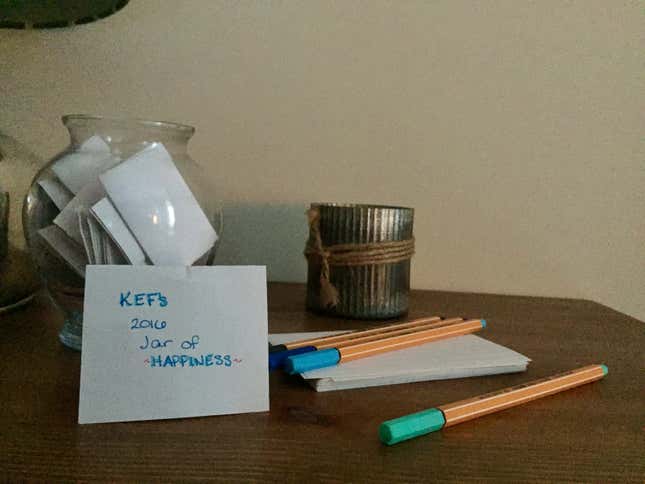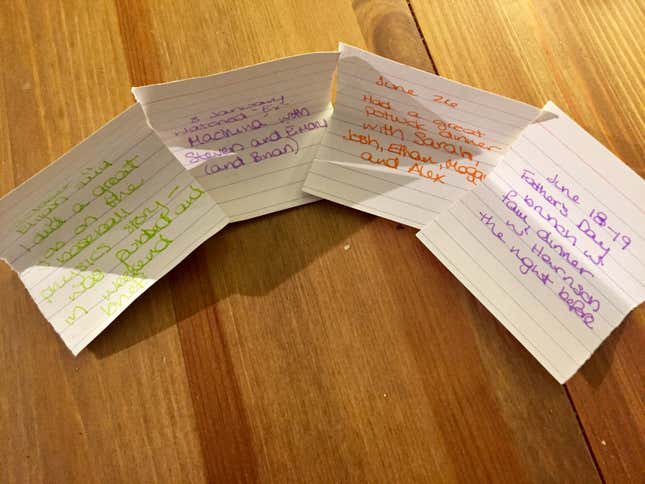One of the best pieces of advice I got in graduate school was from journalist and entrepreneur Christie Nicholson, who taught a class on business entrepreneurship. Whenever you feel sad or upset or uncomfortable, she told me, lean into that feeling, and try to figure out what’s making you react that way—so you can work toward changing it.
This year, I decided to try to apply the same analytical principles to happiness. I wanted to learn what really drives me, and what activities I really love, so that I can build a good life for myself. So in January of this year, I put a little vase, a stack of notecards, and a collection of colorful pens on my breakfast table. In front of the vase, I folded another notecard that reads, “KEF’s 2016 Jar of Happiness.”
I got the idea from a friend of a friend. When visiting his apartment last year, I noticed his roommate had a jar where she wrote down one thing each day that made her happy. It seemed kind of like selective journaling, a practice that psychologists have found helps manage anxiety and depression. But instead of writing down all my feelings, or even something every day, I wanted to write down only my very best memories—thereby generating a specific set of data that would demonstrate what really makes me tick.
I already had some good guesses. My longtime passion for both science and journalism had pushed me through college and graduate school, and finally to Quartz, where I now write about health and science. But at the beginning of 2016, I was starting a new chapter in my life. It was the first time I wasn’t a student, and would be working a regular workweek with actual weekends. It was the first time I was living in a space that was my own, in a city of my choice, rather than subletting a room from a (very lovely) stranger or living on campus housing. And it was the first time in two and a half years that I had been single.
So, through the ups and downs of 2016, I made a point of recording every time I felt overwhelmingly happy, confident, and at peace, and what made me feel that way—just a sentence fragment or two and the date. Nothing was too small to make the cut, and I only had one rule: no memories related to romantic relationships. I wanted to intentionally remind myself of all the other fulfilling things in life that aren’t dating. Over Thanksgiving, I sat down, dumped out the contents of the jar, and sorted through my documented happiness.
In 2016, I was truly, blissfully happy 46 times—at least based on what I wrote down. They fell into four broad categories: Work, friends, family, and health—namely running, which is one of my hobbies.
The overwhelming majority of my happy memories came from work, with 24 instances. Sixteen memories were written after spending time with friends. Eight had to do with family. And two memories had to do with achieving a running goal. One was setting a personal record on a marathon by over 30 minutes. The other was running all the way down a mountain to get to a brewery from my family’s house—roughly 15 miles with an elevation change of about 3,500 feet.
This breakdown makes some intuitive sense. On an hourly basis, I spend the most time at work, followed by time with friends and family. Although I love running, I view it as a regular part my day; it’s not usually special enough to merit entry into my exclusive jar.
But I could analyze what I wrote even further. For example, I already knew that I loved my job, but in going through my moments, I saw that what I really love is setting challenging goals for myself and working to meet them. Thirteen instances came from publishing projects that were really difficult for me. Each of these projects, whether they were written stories or videos or Snapchats, required several revisions and at times made me want to tear my hair out.

For me, learning new, often dense material well enough to write about it conversationally takes a lot of focus, trial and error, and sometimes genuine struggle. The fact that I struggle sometimes makes me anxious. I often think that if I was truly talented and cut out for this field, the material would just come naturally to me. All of my stories would flow beautifully, my editors would say that my first drafts were perfect, and I would be deemed a genius in my early 20s.
But that’s not how my life actually works. One of the moments I included in my jar was the publication of a story I’d written about some of the physics in baseball. While writing that story, I had to concentrate so hard that I put in earplugs to block out office chatter about Chance the Rapper. As I later discovered, they were actually talking about how he was visiting my office, right then, on the same floor where I worked. When I finally came up for air after finishing a lengthy revision, it was the end of the day, and he was gone.
The same day that story was published, I was having lunch with my former editor, Lauren Brown. I asked her how to cope with the feeling of struggling on a story, and whether the feeling ever goes away. I thought she’d say that it just takes practice and patience—which she did. But she also told me that it’s also completely fine to struggle, and that it’s even a good thing if you want to improve.
Her words were really validating. And when my current editor, Elijah Wolfson, told me I had done a good job with the story—and I saw it got a decent amount of readership—both of those moments went into my jar.
These moments helped me recognize my own professional growth. The kinds of stories that made me really proud in the beginning of the year are now articles I’d count as more or less routine. This progression was made possible through hard work on my part, and through the good editors who pushed me to be better. From this, I can gather that struggling is working for me—and that I even find it enjoyable.
Of course, work isn’t everything in life—and it isn’t the only thing that defines my joy. The other major revelation I had about what makes me happy is that my best times were just being with people I really care about.
The times I had truly great nights with my friends, we were just watching a movie or cooking dinner. When my family appears in my jar, it’s moments like catching up at my parents’ home in Virginia or playing catch with my brother in the pool.
I like playing catch, watching movies, and cooking well enough, but I don’t think of them as particularly special. Before I started this project, I might have guessed that my most joyful moments with loved ones would involve big nights out—holidays and birthday parties and concerts and other special occasions. But as it turns out, whom I’m spending time with matters a lot more to me than the activity.

I wrote down a lot of meaningful compliments given to me, too. They came to me in seemingly small moments. Once, Quartz’s editor in chief, Kevin Delaney, told me he thought I was doing good work complementing my colleague’s science coverage. Another time, I wrote down that Elijah had thanked me for my hard work after a long couple of days. When I was going through a particularly rough time this summer, I wrote down when my brother told me he loved me.
I still feel warm when I remember these compliments and moments now. But content-wise, they’re undeniably forgettable. The people I shared them with may not even remember. It would be really easy to dismiss cooking dinner as being too ordinary to record, or to imagine that an editor was just being polite.
But even if I am giving these moments more weight than anyone else would, what’s important is that they matter to me. My happiness jar reminded me that the things bring me joy aren’t far out of reach. No matter how down I may feel in the future, I have these data points that show I am the kind of person who finds joy all around me, and that other people value me. That may not silence self-doubt entirely. But it’s enough to inspire me to trust myself, and to do my best to notice and be present for all the times that bring me joy in the future.
From here, I plan to use this data to shape how I spend my time and energy in 2017. I now have proof that I am the kind of person who finds fulfillment from focusing on her work, friends and loved ones—so I plan to do that more in the year ahead. I’ll write more ambitious stories covering more challenging topics. I’ll plan more dinner parties and movie nights, more trips to the mountains, more time with my brother and family. And more long-distance races, too, because I know how much I love feeling strong.
Conversely, I could probably spend less time and money on extravagant nights out. And I can certainly spend less time worrying about dating; I now have proof that I don’t need a romantic partner to feel like a happy, whole person.
But my favorite thing that I’ve learned from all of this is that the small things that others have done for me mean much to me—which means that the little things I do for others may make that same kind of difference for them. And in that case, it’s worth it to me to always try to be good to the people in my life. You never know whose jar of happiness you may wind up in.
